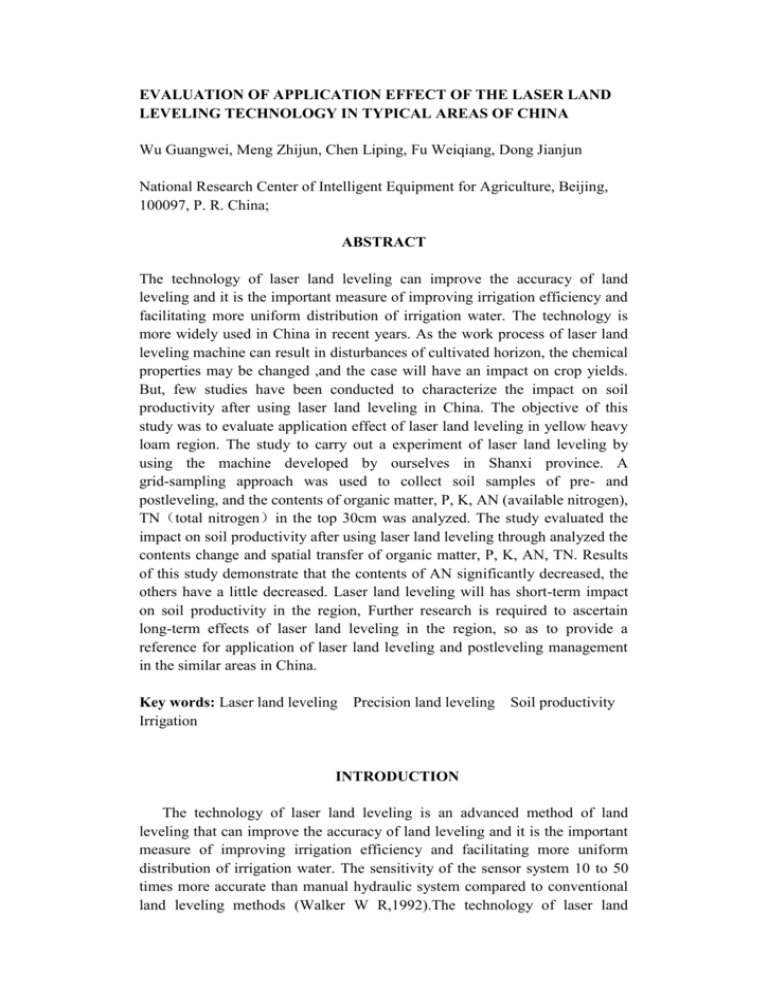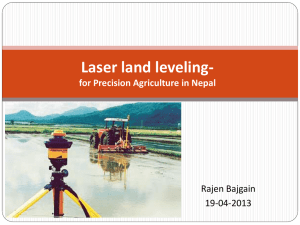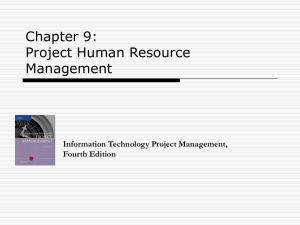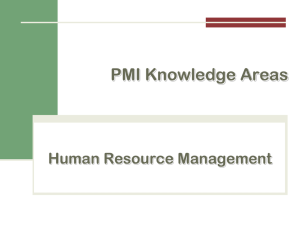Evaluation of application effect of the laser land leveling technology
advertisement

EVALUATION OF APPLICATION EFFECT OF THE LASER LAND LEVELING TECHNOLOGY IN TYPICAL AREAS OF CHINA Wu Guangwei, Meng Zhijun, Chen Liping, Fu Weiqiang, Dong Jianjun National Research Center of Intelligent Equipment for Agriculture, Beijing, 100097, P. R. China; ABSTRACT The technology of laser land leveling can improve the accuracy of land leveling and it is the important measure of improving irrigation efficiency and facilitating more uniform distribution of irrigation water. The technology is more widely used in China in recent years. As the work process of laser land leveling machine can result in disturbances of cultivated horizon, the chemical properties may be changed ,and the case will have an impact on crop yields. But, few studies have been conducted to characterize the impact on soil productivity after using laser land leveling in China. The objective of this study was to evaluate application effect of laser land leveling in yellow heavy loam region. The study to carry out a experiment of laser land leveling by using the machine developed by ourselves in Shanxi province. A grid-sampling approach was used to collect soil samples of pre- and postleveling, and the contents of organic matter, P, K, AN (available nitrogen), TN(total nitrogen)in the top 30cm was analyzed. The study evaluated the impact on soil productivity after using laser land leveling through analyzed the contents change and spatial transfer of organic matter, P, K, AN, TN. Results of this study demonstrate that the contents of AN significantly decreased, the others have a little decreased. Laser land leveling will has short-term impact on soil productivity in the region, Further research is required to ascertain long-term effects of laser land leveling in the region, so as to provide a reference for application of laser land leveling and postleveling management in the similar areas in China. Key words: Laser land leveling Precision land leveling Soil productivity Irrigation INTRODUCTION The technology of laser land leveling is an advanced method of land leveling that can improve the accuracy of land leveling and it is the important measure of improving irrigation efficiency and facilitating more uniform distribution of irrigation water. The sensitivity of the sensor system 10 to 50 times more accurate than manual hydraulic system compared to conventional land leveling methods (Walker W R,1992).The technology of laser land leveling has been widely used in the United States and other countries since the mid-1970s.( Hinz W W,1978; Dednek A R,1982). China has been carried out related research and testing applications through introduce the technology and its products since 1980s, but it is not largely used in agricultural production due to many reasons.Recently, the traditional method of land leveling can not meet the job requirements due to poor accuracy with the development of precision agriculture in China, the technology of laser land leveling is gradually to be applied. The technology of laser land leveling is a method of land leveling. The potential agronomic benefits of land leveling, including the ability to floodirrigate previously nonlevel soils, increased irrigatable acreage, improved distribution of irrigation waters, soil and water conservation, and improved uniformity of crop growth and yield, have been recognized for more than half a century (Whitney et al.,1950), but land leveling also has disadvantages, land leveling is a severe soil disturbance(Brye et al., 2005). The positive effects of land leveling on crop production are equally as numerous as the negative effects of growing crops in exposed subsoil. Nearly the entire equilibrium among is disrupted or altered during the process of land leveling(Brye et al., 2003; 2004c).Many have reported a decline in soil fertility coupled with reduced crop productivity as a result of land leveling. Deficiencies in essential plant nutrients (e.g., N and P) can limit crop growth following land leveling (Whitney et al., 1950; Eck, 1987; Robbins et al., 1997). Exposing subsoil can result in major changes in soil surface pH, decreased organic C, and Na toxicity (Miller, 1990).Land leveling has been shown to significantly alter magnitudes and variability of numerous soil physical and chemical properties in a silt-loam soil (Brye et al., 2003; 2004c). The previous researches prove many researcher studied the short-term impact on soil physical, chemical, and biological properties after land leveling according to the local soil conditions. The results of the study provides a useful guide to the operations of land leveling and agricultural production subsidy policy for local producer and government. But, few studies have been conducted to characterize the impact on soil productivity after using laser land leveling in China. Most studies only shows application and operating accuracy changes of the laser land leveling technology. The study result only prove that the technology improve irrigation efficiency and uniformity.The objective of this study was to evaluate application effect of laser land leveling in yellow heavy loam region of China. The study carry out a experiment of laser land leveling by using the machine developed by ourselves in Shanxi province(The major grain producing areas in the middle of China).A grid-sampling approach was used to collect soil samples of pre- and postleveling, and the contents of OM(organic matter), P, K, AN (available nitrogen), TN(total nitrogen)in the top 20cm was analyzed. The study evaluated the impact on soil productivity after using laser land leveling through analyzed the contents change and spatial transfer of organic matter, P, K, AN, TN. So as to provide a reference for application of laser land leveling and postleveling management in the similar areas in China. MATERIALS AND METHODS Site Description The study site is located in Wenxi County, Yuncheng, Shanxi Province(35o21'N Lat., 111°20'E Long.). The area is flat plain in the piedmont, tilted from northeast to southwest. The elevation is 600m to 762m, local farmers built long stripe cropland in accordance with the natural terrain to meet irrigation needs. The soil of the area is yellow heavy loam. The OM, TN and total P content is lower in the surface soil, the OM content is 1.68%, TN content is 0.108%, P content is 0.026% and PH is 8.1. The arable layer thickness of experiment site is more than 50cm, the humus layer is thick and soil have the better fertility. In the study, 10 typical fields were chosen to take the experiment, every field is long strips and the area is about 0.7-ha, the total area of the experiment field is about 8-ha. Experimental equipment The study operate land leveling using a laser land leveling machine. The machine model is 1PJ-2500 that is developed by National Research Center of Intelligent Equipment for Agriculture(IEA). The part of 1PJ-2500 laser land leveling machine include the laser transmitter, laser receiver, controller, hydraulic shovel etc., the main structure shown in Fig.1. The equipment working width of 2.5m, the accuracy of land leveling of ±2 cm, working radius of 400m, the power was used in the experiment was 58.8kW tractor. 1-wheels,2-baffle,3-blade,4-oblique rod,5-traction frame, 6-pulling force sensor, 7-adjustment device,8-hydraulic tank,9-air filter,10-electromagnetic valve, 11-laser receiver,12-slide,13-transmission,14-hydraulic moto,15-hydraulic cylinder Fig.1 The main structure of 1PJ-2500 laser land leveling machine Experimental Design The grid-sampling approach employed in this study. Before land leveling, every study area containing a 6-point grid was established with sampling points spaced evenly 30 m apart. Soil samples were collected at the start of the experiment from0 to 30-cm soil depth using sampling equipment. Each sampling point use equipment to sample three times.The soil sample was saved in a sealed bags and each bag was numbered. After the sampling process, two 1PJ-2500 laser land leveling machine was used to land leveling in the study fields and every field can reach the accuracy of land leveling of ±2 cm. After land leveling, RTK-GPS was used to find the same sampling points in order to make the samples of postleveling corresponds exactly with the samples of preleveling. The same sampling approach was used after land leveling. The samples of preleveling and postleveling have 60 groups. Data Manipulation and Statistical Analyses The 60 groups soil samples was commissioned to the authority laboratory(Beijing Research center for Agrifood Testing and Farmland Monitoring)analyzed the contents of organic matter, P, K, AN, TN. 60 groups data of the soil sample contents of organic matter, P, K, AN, TN of preleveling and postleveling was get through assay. Before data analysis, abnormal data in the sample space was excluded, the principle is whether the data out of the sample mean three times the sample error.Through data filter, the sample include 46 groups data of preleveling and postleveling. Data were subjected to analysis of variance (ANOVA), correlation coefficient and significant differences. In the study, X b and X a express the average of soil nutrient factors of preleveling and postleveling(Formula 1, Formula 2). Xb Xa nb i 1 Xi (1) nb na i 1 Xi (2) na S b and S a express the sample variance of sample soil nutrient factor of preleveling and postleveling(Formula 3, Formula 4). Sb 1 nb Sa 1 na nb (X i 1 bi na (X i 1 ai X b )2 X a )2 (3) (4) CVb and CVa express variance coefficient of sample factor of preleveling and postleveling(Formula 5, Formula 6). CVb Sb Xb (5) CVa Sa Xa (6) Because the sample space length of soil properties data is greater than 30, the z-test was used to test whether the sample mean preleveling equal the data postleveling. Formula 7 and 8 express the test statistic of two sample comparison of z-test. Xb X a SXb X a Z (7) S X b Xa Sb2 / nb Sa2 / na (8) In order to test whether hd (Field surface height difference) have the correlation with X d (The soil physical and chemical factors), the study use the r-test method test linear correlation(Formula 9). r is the R value of a significance test in the test. n r (X i 1 n (X i 1 di di X d )(hdi hd ) Xd ) (9) n 2 (h i 1 di hd ) 2 RESULTS AND DISCUSSION Spass software (Version 11) was used to calculate the data, the average , average variance and variance coefficient of the content of organic matter, P, K, AN, TN preleveling and postleveling(Table 1). Table 1. The average, average variance and variance coefficient of the content of organic matter, P, K, AN, TN preleveling and postleveling Preleveling Postleveling Soil chemical property Average Average variance Variance coefficient Average Average variance Variance coefficient OM(%) P(mg/kg) K(mg/kg) AN(mg/kg) TN(%) 0.9344 5.8372 115.3717 51.5603 0.0808 0.2040 2.6640 22.5766 37.4121 0.0082 21.8% 45.6% 19.6% 72.6% 10.2% 0.8892 6.1121 110.8835 38.6636 0.0805 0.1844 3.8575 18.5957 20.1716 0.0176 20.7% 63.1% 16.7% 52.2% 21.9% The analysis test the hypothesis in significance level 0.05 , get Z-value through formula 7 and 8 process the OM content data of preleveling and postleveling , Z = 5.82, the normal distribution table show 1.96 , 1 Z> 1 2 . The conclusion is the OM content of preleveling and postleveling 2 have significant difference from the data analysis. In order to evaluate the influence of elevation change of preleveling and postleveling to the OM content, the study calculate R-value use formula 9, R= 0.454, the critical value of the correlation coefficient ra is 0.2785 when n=6 and a=0.05. Through hypothesis testing, it is suggested that the organic matter content and elevation change have a certain correlation. In the same analytical methods, we can get Z-value of P, K, AN, TN is 0.12,0.05, 0.0613,5.62. The study conclude that the P, K, AN content of preleveling and postleveling have no significant difference from the data analysis , and the TN content of preleveling and postleveling have significant difference. The R-value of P, K, AN, TN is 0.0841,0.233,-0.0927, 0.3264. The study conclude that the P, K, AN content and elevation change have no significant correlation, the TN content and elevation change have a certain correlation. Table 2. Statistics of soil nutrients preleveling and postleveling K(mg/kg) AN(mg/kg) OM(%) TN(%) P(mg/kg) 0.9344± 0.0808± 5.8372± 115.3717± 51.5603± 0.2040 0.0082 2.6640 22.5766 37.4121 0.8892± 0.0805± 6.1121± 110.8835± 38.6636± 0.1844 0.0176 3.8575 18.5957 20.1716 Preleveling postleveling Table 2 list the statistics of the content of OM, P, K, AN, TN preleveling and postleveling, we can see the content average of OM, K, AN, TN postleveling have a certain decrease, and the content average of P postleveling increased. The content average of AN have a more decreased , the data show land leveling have a greater impact on AN of the experimental area. According to “Classification of cropland and farmland fertility” (NY-T309-1996) that issued by the Ministry of Agriculture of China, the soil fertility of the experimental area can reach the level of seven grade. CONCLUSIONS Most people think that the agricultural management practice of laser land leveling to facilitate more uniform and economical distribution of irrigation water to crops like rice and soybean is a severe form of soil disturbance. In China, this view affect the application of laser land leveling in a certain extent. In the study, the analysis results show that laser land leveling have a certain influence on the soil fertility(The content of OM,TN,P,K,AN), but the farmland productivity have less destructive compare to traditional land leveling methods in yellow heavy loam region. The loss of soil fertility can reach the level preleveling through using fertilizers in 2-3 years. The technology of laser land leveling is the important measure of improving irrigation efficiency and facilitating more uniform distribution of irrigation water. Further research is required to ascertain long-term effects of laser land leveling in the region, so as to provide a reference for application of laser land leveling and postleveling management in the similar areas in China. Acknowledgement: This work is supported by National Key Technology Research and Development Program of the Ministry of Science and technology of China (2011BAD04B05) . REFERENCES Walker W R.Guidelines for designing and evaluating surface irrigation systems.FAO Irrigation and Drainage Paper No.45,1992 Rome Hinz W W ,and Halderman A D.Laser beam land leveling Cost and benefits Bul1.No A1 14 Coop Ext Ser .1978.Tucs0n.Arizona Dednek A R,Erie I J,and Clemmens A J Lever-basin irrigation. In Advances in Irrigation Vo1.2 Hillel,D Ied ,Aendemic Press,1982. New York Whitney, R.S., R. Gardner, and D.W. Robertson. 1950. The effectiveness of manure and commercial fertilizer in restoring the productivity of subsoils exposed by leveling. Agron. J. 42: 239–245. Brye, K.R., N.A. Slaton, and R.J. Norman. 2005. Penetration resistance as affected by shallow-cut land leveling and cropping. Soil Till. Res. 81:1–13. Brye, K.R., N.A. Slaton, M.C. Savin, R.J. Norman, and D.M. Miller. 2003. Short-term effects of land leveling on soil physical propertiesand microbial biomass. Soil Sci. Soc. Am. J. 67:1405–1417. Brye, K.R., N.A. Slaton, M. Mozaffari, M.C. Savin, R.J. Norman, and D.M. Miller. 2004c. Short-term effects of land leveling on soil chemical properties and their relationships with microbial biomass. Soil Sci. Soc. Am. J. 68:924–934. Eck, H.V. 1987. Characteristics of exposed subsoil—At exposure and 23 years later. Agron. J. 79:1067–1073. Han Bao.2003. Development of 1JPY-3.0 laser controlled compositive leveling machine. Transactions of the Chinese Society of Agricultural Engineering19:116-119 (in Chinese). Lin Jianhan, Liu Gang, Wang Maohua, Si Yongshen. 2007. Development and Performance Test of a Laser Controlled Land Leveling Machine Agricultural mechanization in asia, africa and Latin Amercia. 38:48-52. Robbins, C.W., B.E. Mackey, and L.L. Freeborn. 1997. Improving exposed subsoils with fertilizers and crop rotations. Soil Sci. Soc. Am. J.61:1221–1225. Miller, D.M. 1990. Variability of soil chemical properties and rice growth following land leveling. Ark. Farm Res. 39:4.








